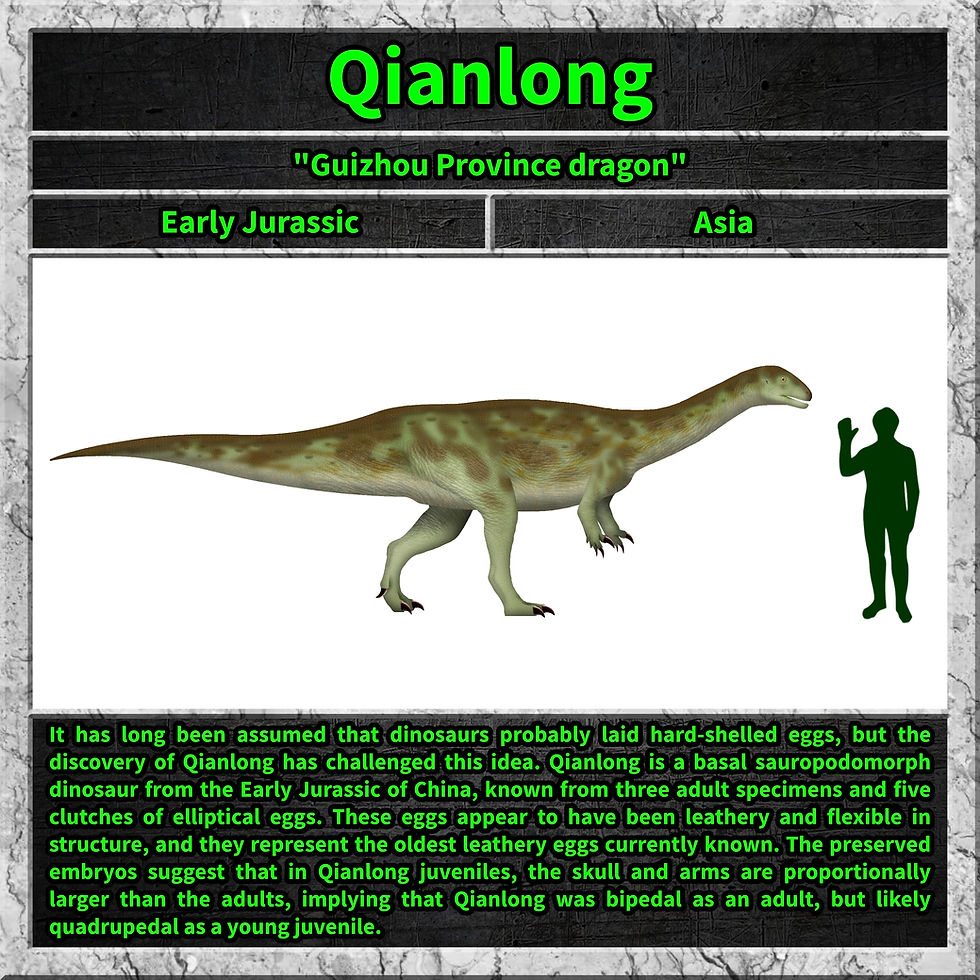Qianlong
- unexpecteddinolesson
- Sep 22, 2024
- 3 min read
MEANING: Guizhou Province dragon
PERIOD: Early Jurassic
CONTINENT: Asia
It has long been assumed that dinosaurs probably laid hard-shelled eggs, but the discovery of Qianlong has challenged this idea. Qianlong is a basal sauropodomorph dinosaur from the Early Jurassic of China, known from three adult specimens and five clutches of elliptical eggs. These eggs appear to have been leathery and flexible in structure, and they represent the oldest leathery eggs currently known. The preserved embryos suggest that in Qianlong juveniles, the skull and arms are proportionally larger than the adults, implying that Qianlong was bipedal as an adult, but likely quadrupedal as a young juvenile.

Abstract from paper: Our understanding of pre-Cretaceous dinosaur reproduction is hindered by a scarcity of evidence within fossil records. Here we report three adult skeletons and five clutches of embryo-containing eggs of a new sauropodomorph from the Lower Jurassic of southwestern China, displaying several significant reproductive features that are either unknown or unlike other early-diverging sauropodomorphs, such as relatively large eggs with a relatively thick calcareous shell formed by prominent mammillary cones, synchronous hatching and a transitional prehatching posture between the crocodilians and living birds. Most significantly, these Early Jurassic fossils provide strong evidence for the earliest known leathery eggs. Our comprehensive quantitative analyses demonstrate that the first dinosaur eggs were probably leathery, elliptical and relatively small, but with relatively long eggshell units, and that along the line to living birds, the most significant change in reptilian egg morphology occurred early in theropod evolution rather than near the origin of Aves.
Qianlong is from the Jurassic. The Jurassic is a geologic period that spanned from the end of the Triassic, 201 million y ears ago, to the beginning of the Cretaceous, 145 million years ago. It is the middle period of the Mesozoic Era. The start of the Jurassic was marked by the major Triassic-Jurassic extinction event. The end, however, has no clear boundary with the Cretaceous. By the beginning of the Jurassic, Pangea had begun rifting into two landmasses: Laurasia and Gondwana, and the climate was warm with no ice caps. Life on land was dominated by dinosaurs, and the first birds appeared, evolving from a branch of theropods. The oceans were inhabited by marine reptiles, while pterosaurs were the dominant flying vertebrates.
Qianlong is a sauropodomorph. Sauropodomorpha is a group long-necked, herbivorous, saurischian dinosaurs that includes the sauropods and their ancestral relatives. Sauropods generally grew to very large sizes, had long necks and tails, were quadrupedal, and became the largest animals to ever walk the Earth. The prosauropods, which preceded the sauropods, were smaller and often able to walk on two legs. The sauropodomorphs were the dominant terrestrial herbivores throughout much of the Mesozoic Era, from their origins in the Late Triassic until their extinction at the end of the Cretaceous.
Sauropodomorphs had a light, tiny skull on the end of a long neck and a counterbalancing long tail. These adaptations gave them access to high tree foliage. The earliest known sauropodomorphs were small and slender, but by the end of the Triassic, they were the largest dinosaurs of their time, and throughout the Jurassic and Cretaceous they continued growing. They were initially bipedal, but as their size increased they evolved a four-legged gait adapted only to walking slowly on land. The early sauropodomorphs were most likely omnivores as they were only recently diverged from the carnivorous theropods.












